Excerpts from Jim Conrad's
Naturalist Newsletter
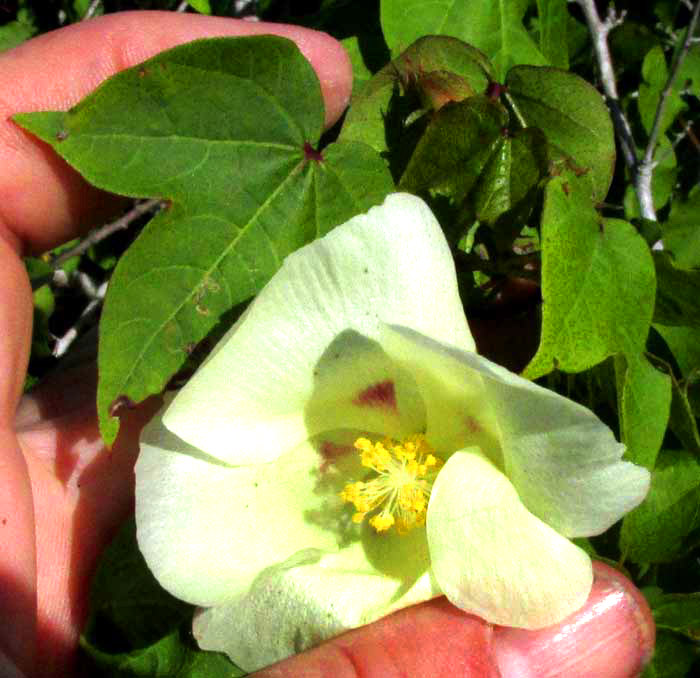
from the November 2, 2014 Newsletter issued from Río Lagartos, on the Yucatan Peninsula's northern coast (~N21.60°, ~W88.16°), Yucatán state, MÉXICO
WILD UPLAND COTTON
Just beyond the Las Coloradas salt ponds on the coast about 25 kms east of Río Lagartos a sandy road runs behind dunes along the shore. The dunes are thickly vegetated with grasses, yuccas, Goat's-foot Morning-glory and other low-lying plants. Below, you can see a typical stretch:
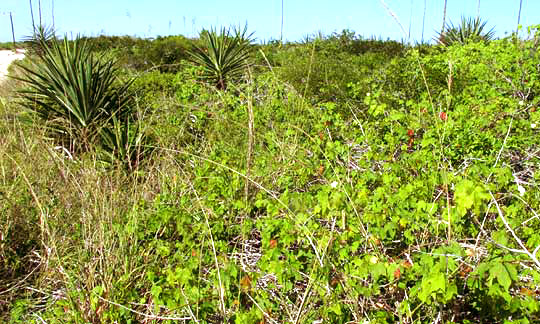
On the right side of that picture notice that some plants bear egg-sized, whitish flowers. A close-up of the plant's flower and leaves is at the top of this page.
That looks like cotton. A side-view of a broken-open flower showing how the stamens' filaments all attach to a cylinder around the ovary's style is shown below:
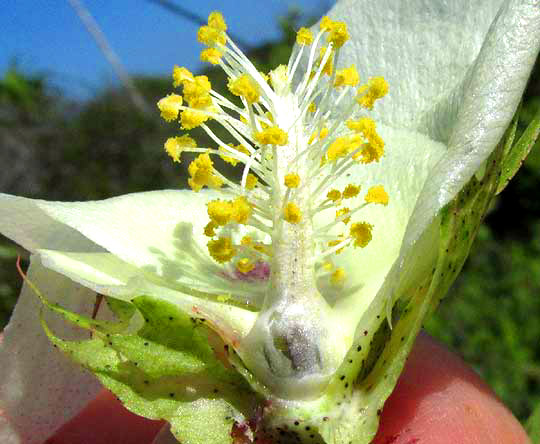
The flower's stamens confirm the plant's membership in the big Hibiscus Family, the Malvaceae, to which cotton plants belong. Also, notice that vegetative sepals below the corolla are sprinkled with black dots, and that the ovary is a big one causing a bulge at the stamen column's base, all like cotton. And when I looked around, some plants bore old flowers from which the corollas had fallen, leaving behind egg-shaped ovaries developing into black-spotted "bolls" nearly surrounded by the enlarging, leafy calyx -- all like cotton -- as seen below:
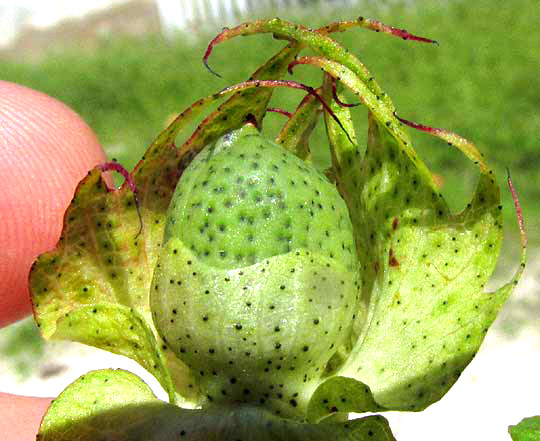
Well, it IS cotton, GOSSYPIUM HIRSUTUM, the species usually called Upland Cotton or Mexican Cotton, the very species constituting 95% of all cotton produced in the US, and about 90% of cotton planted in the rest of the world. Our dune plants are the wild race known as Gossypium hirsutum 'yucatanense,' limited in distribution to the Yucatan Peninsula's northern coast. The importance of the wild-growing cotton along the Yucatan Peninsula's northern coast is made clear in a study by d'Eeckenbrugge and Lacape published in September, 2014, where it's stated that "... upland cotton domestication was very probably initiated in its largest native population, in northern Yucatán."
So, a preponderance of the world's cotton industry is based on genes supplied by our northern Yucatan dune plants. These northern Yucatan plants are known to be exceedingly genetically diverse, and this genetic diversity may be of special importance to the world's cotton growers as new cotton cultivars must be developed to deal with global warming, growing salinization of irrigated land, and other unforeseen future challenges.
Unfortunately, all populations of wild races of cotton may be threatened by extensively planted, genetically modified cotton. GMO cotton plants all bear the same genetic material, and their genes have been modified to serve industrial purposes, not to help the plants survive in the wild. Wild cotton populations already may have been contaminated with human-manipulated genetic material. Also there's evidence suggesting that wild cotton populations in Hawaii, Brazil and the Galapagos are in danger of extinction by hybridizing with domesticated cotton. The GMO threat and the problems with hybridization are discussed in a 2013 paper by Ana Laura Wegier, entitled "Diversidad genética y conservación de Gossypium hirsutum silvestre y cultivado en México."
It's good that these genetically diverse cotton plants in dunes along the northern Yucatan coast are protected within the Ría Lagartos Biosphere Reserve.
from the November 9, 2014 Newsletter issued from Río Lagartos, on the Yucatan Peninsula's northern coast (~N21.60°, ~W88.16°), Yucatán state, MÉXICO
BOLES OF WILD COTTON
Last week we looked at the narrowly endemic, genetically diverse, woody stemmed wild ancestors of much-planted Upland Cotton growing among dunes of the Yucatan's northern coast. At that time I couldn't find mature fruits and seeds but this week I did. Below you can see an open capsular boll with white cotton fiber tumbling out, covering hard, spherical, blackish seeds:
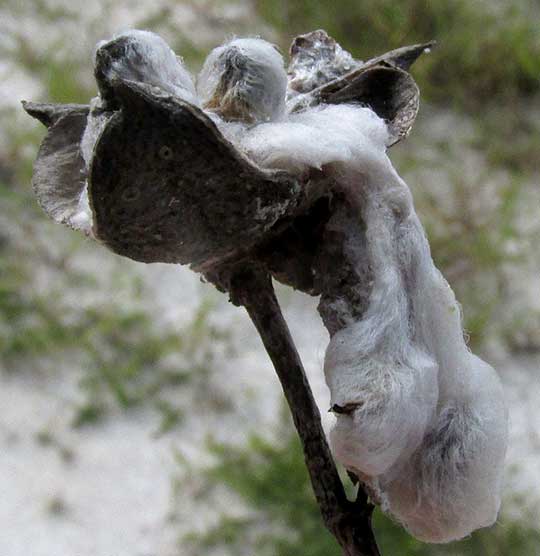
Another shot showing a black seed (upper right) and a split-open capsule is shown below:
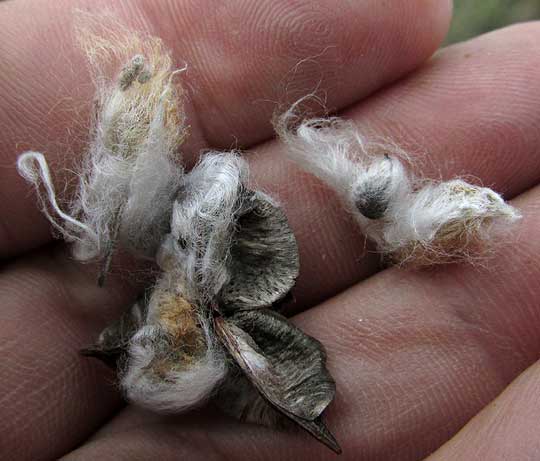
Here you can see that these seeds are fairly large compared to the small size of the capsule producing them.
from the November 16, 2014 Newsletter issued from Río Lagartos, on the Yucatan Peninsula's northern coast (~N21.60°, ~W88.16°), Yucatán state, MÉXICO
UPLAND OR SEA-ISLAND COTTON?
The following is a little technical but I'm including it because the presence of wild cotton here on the Yucatan's northern coast is important, and the exact identity of the various cottons can be hard to determine.
The wild Upland Cotton, Gossypium hirsutum, we've documented in the last two Newsletters as growing among the dunes here on the Yucatan's northern coast raised some questions with me. For, both Upland and Sea-Island Cotton (the latter being Gossypium barbadense, of South American origin) are listed as growing in the Ría Lagartos Biosphere Reserve. These two species are very closely related, very similar, and are known to hybridize. Therefore, I've been double-checking my identifications.
Even features of well defined plants of each species overlap a great deal, though a practiced eye usually can tell them apart. Here's a review of certain differences between the two species as detailed in PA Fryxell's 1992 treatment of the Hibiscus Family in the Flora de Veracruz:
| G. BARBADENSE | G. HIRSUTUM | |
| leaves | 3-7 lobed | 3-5 lobed |
| leaf middle lobe | oval to lance-shaped | oval to triangular |
| leaf middle lobe | > 1.5 x longer than wide | < 1.5 x longer than wide |
| capsular fruits | 3 cells | 3-5 cells |
| capsular fruits | narrowly ovoid | ovoid |
| bracts | 5-17 teeth | 3-19 teeth |
| bract sinuses | rounded/ U-shaped | more or less V-shaped |
LH Bailey's 1949 Manual of Cultivated Plants further distinguishes them by saying that G. barbadense's anthers are "compactly arranged on uniformly short filaments" while anthers of G. hirsutum are "loosely arranged on filaments of varying lengths." If you're at a loss as to what's "compact" and what's "loose" in anther terms, pictures on the Internet can help develop an eye for this feature.
First take a look at the yellow, "compact" cluster of anthers in a public-domain picture of a G. barbadense flower made available by CT Johansson of Sweden, shown below:
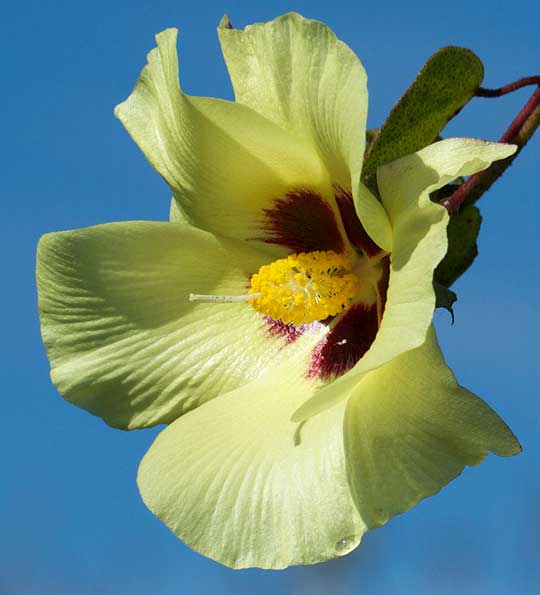
Compare those anthers with the ones in our own G. hirsutum flower from local northern Yucatán dunes shown toward the top of the page.
To me this matter of compact and loose filaments seems to be the most dependable for distinguishing the two species. Using that feature, I find that maybe all the cotton plants I've seen so far in the Yucatan -- wild and planted next to Maya huts, both low herbs and woody, small trees -- have been Upland Cotton, Gossypium hirsutum.
from the January 4, 2015 Newsletter issued from Río Lagartos, on the Yucatan Peninsula's northern coast (~N21.60°, ~W88.16°), Yucatán state, MÉXICO
WHITE & BROWN COTTON FIBERS
We've noted that wild cotton grows naturally in several places in Mexico, but that the genes of commercially grown cotton largely originated with our wild cotton plants along the Yucatan Peninsula's northern coast. Therefore, our wild cotton plants are important as a reservoir for genetic diversity of the commercial species.
If commercial cotton plants, with little genetic diversity, develop diseases or must be bred to accommodate changes wrought by global warming, our plants may well offer genes that could be usefully inserted into the commercial cotton genome. It's been pointed out that our coastal plants have good reason to be genetically diverse, since during their evolutionary history the sea level has risen and fallen repeatedly with special consequences for coastal species, plus our area is very vulnerable to hurricanes, and the sandy, windblown dunes with lots of salt in the environment are stressful environments to begin with.
One aspect of the diversity of our coastal cotton plants is that the fiber being exposed nowadays as the plants' bolls open during our early dry season is that the fibers range in color from pure white to brownish. Below, this is shown on opening bolls collected just a few kilometers from one another:
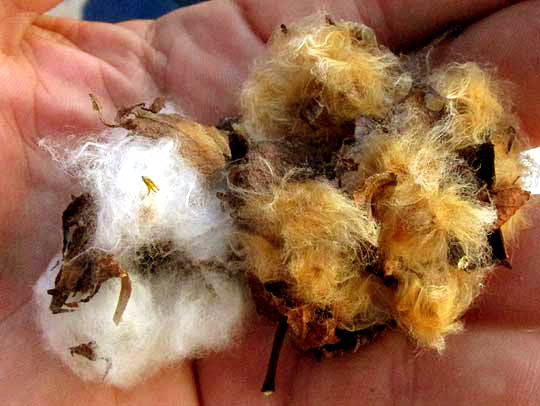
Plants in a small area normally display all the same color, but if you relocate a little down the road it's quite possible that different-colored fibers will dominate at your new location. Supposedly other variations in the plant also are present, both physically and physiologically. It's just that fiber color is so easy to see.